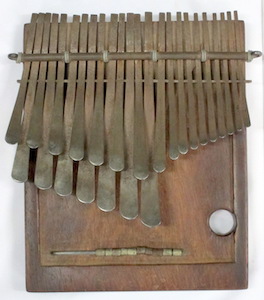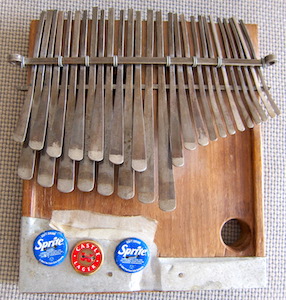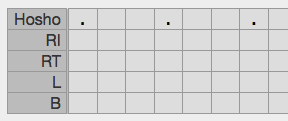The numbers indicate the key positions in each of the three playing areas from bottom to top.
Following common practice,
the B2x extension key is given its own name instead of shifting all subsequent numbers by one.
Key Overview
The table below shows all keys of the notation, from lowest to highest.
Each row contains all possible keys for that playing area.
Each column contains all keys of the same pitch.
Not all instruments may have keys matching all these notes.
Red notes are
alias names
for the same key, if it can be played with different fingers.
| Hosho | . | | | | | | | | | | | | | | | | | | | | | | | | | | |
| RI | | | | | | | | | | | | | | | | | | 4 | 5 | 6 | 7 | 8 | 9 | 10 | 11 | 12 | 13 |
| RT | | | | | | | | | L1 | | 1 | | | | | 2 | 3 | 4 | 5 | 6 | | | | | | | |
| L | | | | | | | | | 1 | | RT1 | 3 | 2 | 4 | 5 | 6 | 7 | | | | | | | | | | |
| B | | 1 | 2x | 2 | 3 | 4 | 5 | 6 | | 7 | | | | | | | | | | | | | | | | | |
Aliases
The table below lists all alias keys.
Row names are shown in black, cell content in red.
| Key | Alias | Notes |
|---|
| L1 | RTL1 | L1 key played with the right thumb |
| RT1 | LRT1 | RT1 key played with the left thumb |
| RI4 | RT4 | RI4 key played with the thumb instead of the index finger |
| RI5 | RT5 | RI4 key played with the thumb instead of the index finger |
| RI6 | RT6 | RI4 key played with the thumb instead of the index finger |
Like
Pitch+Octaves notation, but octave indication is omitted where can be deduced from the playing area.
If a manual contains the same pitch class twice, the less frequently used key gets the octave indication.
Caveat: The notation uses two single quotes (''), not a double quote (") for the highest register.
Key Overview
The table below shows all keys of the notation, from lowest to highest.
Each row contains all possible keys for that playing area.
Each column contains all keys of the same pitch.
Not all instruments may have keys matching all these notes.
Red notes are
alias names
for the same key, if it can be played with different fingers.
| Hosho | . | | | | | | | | | | | | | | | | | | | | | | | | | | |
| RI | | | | | | | | | | | | | | | | | | 3 | 4 | 5 | 6 | 7 | 1 | 2 | 3'' | 4'' | 5'' |
| RT | | | | | | | | | L1 | | 3 | | | | | 1 | 2 | 3' | 4 | 5 | | | | | | | |
| L | | | | | | | | | 1 | | RT3 | 4 | 5 | 6 | 7 | 1' | 2 | | | | | | | | | | |
| B | | 1 | 2, | 3 | 4 | 5 | 6 | 7 | | 2 | | | | | | | | | | | | | | | | | |
Aliases
The table below lists all alias keys.
Row names are shown in black, cell content in red.
| Key | Alias | Notes |
|---|
| L1 | RTL1 | L1 key played with the right thumb |
| RT3 | LRT3 | RT3 key played with the left thumb |
| RI3 | RT3' | RI3 key played with the thumb instead of the index finger (Note the RT3', as there is also RT3) |
| RI4 | RT4 | RI4 key played with the thumb instead of the index finger |
| RI5 | RT5 | RI5 key played with the thumb instead of the index finger |
The numbers denote scale degrees (1-7) of the mbira's seven tone scale,
starting with
1 as the lowest tone of both the L and B registers.
Apostrophes and commas indicate the octave position relative to the middle register. e.g.
1, 1 1' 1''.
Caveat: The notation uses two single quotes (''), not a double quote (") for the highest register.
Key Overview
The table below shows all keys of the notation, from lowest to highest.
Each row contains all possible keys for that playing area.
Each column contains all keys of the same pitch.
Not all instruments may have keys matching all these notes.
Red notes are
alias names
for the same key, if it can be played with different fingers.
| Hosho | . | | | | | | | | | | | | | | | | | | | | | | | | | | |
| RI | | | | | | | | | | | | | | | | | | 3' | 4' | 5' | 6' | 7' | 1'' | 2'' | 3'' | 4'' | 5'' |
| RT | | | | | | | | | 1 | | 3 | | | | | 1' | 2' | 3' | 4' | 5' | | | | | | | |
| L | | | | | | | | | 1 | | 3 | 4 | 5 | 6 | 7 | 1' | 2' | | | | | | | | | | |
| B | | 1, | 2, | 3, | 4, | 5, | 6, | 7, | | 2 | | | | | | | | | | | | | | | | | |
Aliases
The table below lists all alias keys.
Row names are shown in black, cell content in red.
| Key | Alias | Notes |
|---|
| L1 | RT1 | L1 key played with the right thumb |
| RT3 | L3 | RT3 key played with the left thumb |
| RI3' | RT3' | RI3' key played with the thumb instead of the index finger |
| RI4' | RT4' | RI4' key played with the thumb instead of the index finger |
| RI5' | RT5' | RI5' key played with the thumb instead of the index finger |
The
Analytic notation can be used to analyze and transform the harmonic and rhythmic
structure of mbira pieces, and to compose new music.
There are two kinds of tracks in this notation:
- Tracks with notes (the first five rows of the table above)
- Transposition tracks (the row at the bottom)
An equals sign (
=) in a transposition track indicates repetition,
making
1==3== the same as
111333.
Each number (or repetition) in the bottom track transposes all notes in the respective column.
The caption of the bottom track (
4) in turn transposes the entire transposition track.
Playground for experimentation
The resultant piece in the picture is a well-known
Nhemamusasa kushaura part.
The bottom row contains the
System of Mbira-style
harmonic "standard" progression
135-136-146-246, which is lifted to the fourth
degree by the
4 in the bottom left corner, thus
461-462-472-572.
The
= signs nicely visualize the harmonic rhythm of the piece.
With all harmonic information factored out, you can see how the remaining pattern merely contains unisons,
fifths, and occasional thirds, and is repeated four times in near identical form.
Looping backgrounds allow you to state this pattern only once.
On this level of abstraction, you can transform the entire piece simply by changing or moving a
single number.
Try it out and learn more techniques with
this demonstration piece.
Adding degrees
All numbers in the table range from
1-
7
and denote either scale degrees or transpositions.
Since we are counting 1-7, not 0-6, the way two degrees
a and
b
add up is not a plain addition.
Therefore let us not use
a+b, but a new symbol
a°b,
meaning "
a lifted to the
b-th degree".
Here is how
° works: Take
a + b - 1, and subtract 7 if the result
is bigger than 7.
| ° | 1 | 2 | 3 | 4 | 5 | 6 | 7 |
| 1 | 1 | 2 | 3 | 4 | 5 | 6 | 7 |
| 2 | 2 | 3 | 4 | 5 | 6 | 7 | 1 |
| 3 | 3 | 4 | 5 | 6 | 7 | 1 | 2 |
| 4 | 4 | 5 | 6 | 7 | 1 | 2 | 3 |
| 5 | 5 | 6 | 7 | 1 | 2 | 3 | 4 |
| 6 | 6 | 7 | 1 | 2 | 3 | 4 | 5 |
| 7 | 7 | 1 | 2 | 3 | 4 | 5 | 6 |
This way of adding degrees may be unfamiliar at first, but has the advantage of all numbers in the table
being interchangeable.
Mapping notes
The
Analytic notation works like an abstract mbira,
with all degrees 1-7 available in all tracks.
| Hosho | . | | | | | | | | | | | | | | | | | | | | | | | | | | | | |
| RI | | | | | | | | | | | | | | | | | | | | | | | 1 | 2 | 3 | 4 | 5 | 6 | 7 |
| RT | | | | | | | | | | | | | | | | 1 | 2 | 3 | 4 | 5 | 6 | 7 | | | | | | | |
| L | | | | | | | | | 1 | 2 | 3 | 4 | 5 | 6 | 7 | | | | | | | | | | | | | | |
| B | | 1 | 2 | 3 | 4 | 5 | 6 | 7 | | | | | | | | | | | | | | | | | | | | | |
On the real instrument, however, not all scale degrees are present in all manuals.
E.g. the
RT manual is made of degrees
1-
3 only.
Therefore, when playing back the piece, or when translating it to another notation,
all notes must be mapped to existing keys.
When a note is not available in a manual, it can be either moved to another manual or octave, or
get substituted, harmonically informed by the transposition tracks.
There are a number of methods for this, each trying to retain a different aspect of the abstract mbira
piece.
- Retain Pitches. Notes move to where they are found on the instrument.
E.g. the non-present L3 key is moved to RT3 of the same pitch.
This may result in pieces not being playable, e.g. if the right thumb is already busy with another
key.
- Retain Motor Pattern. Each note not present in a manual is substituted by
a harmonic equivalent, so that fingers keep playing the same motor pattern.
This sometimes leads to large interval jumps,
especially between RT and RI keys,
and many note repetitions in the RT manual.
- Retain Octaves: Map notes so that they remain within three registers
- All B keys → low register: B1-B7
- All L keys → middle register: L1-L7
including B2 and RT3
- All RT/RI keys → high register: RT1-RT7,
transposing down RI1 and RI2
- Retain Playability. A mix of the above mappings, striving to maximize playbility
of the resultant part - given that the abstract part itself is playable.
Hint: When composing pieces or exploring variations, it is generally best to start with the
Retain Pitches method, and then trying the others for getting the result to the instrument.
For technical reasons, you choose the method via the Notation drop-down list.
The same Analytic notation is listed four times, indicating the mapping method.
To change the method, simply pick another "Analytic (...)" entry.
Transposition track rules
- You can use any number of transposition tracks. They all add up.
- An empty cell means that the track does not affect the transposition of that column.
- If no number is found left of an = cell up to the beginning of a track
(empty cells skipped), the lookup continues from the end of the track.
This means you can always safely rotate transposition tracks along with the
notes.
- If a transposition track contains no number at all, but only =,
the number 1 is substituted, allowing for purely graphical transposition
patterns.
Miscellaneous
- The L1' key is currently not reachable by Analytic notation.
This means you cannot transcribe the popular RT1 L1' RT1 L1' RT1 L1'...
figure in some mbira pieces, but have to use RT1 RT1 RT1 RT1... instead.
This will likely change in a future update.
-
You can use any positive number, not just 1-7 in the tables. The general formula
for combining degrees is a°b = 1 + (a-1 + b-1) mod 7.



 There are two kinds of tracks in this notation:
There are two kinds of tracks in this notation:



